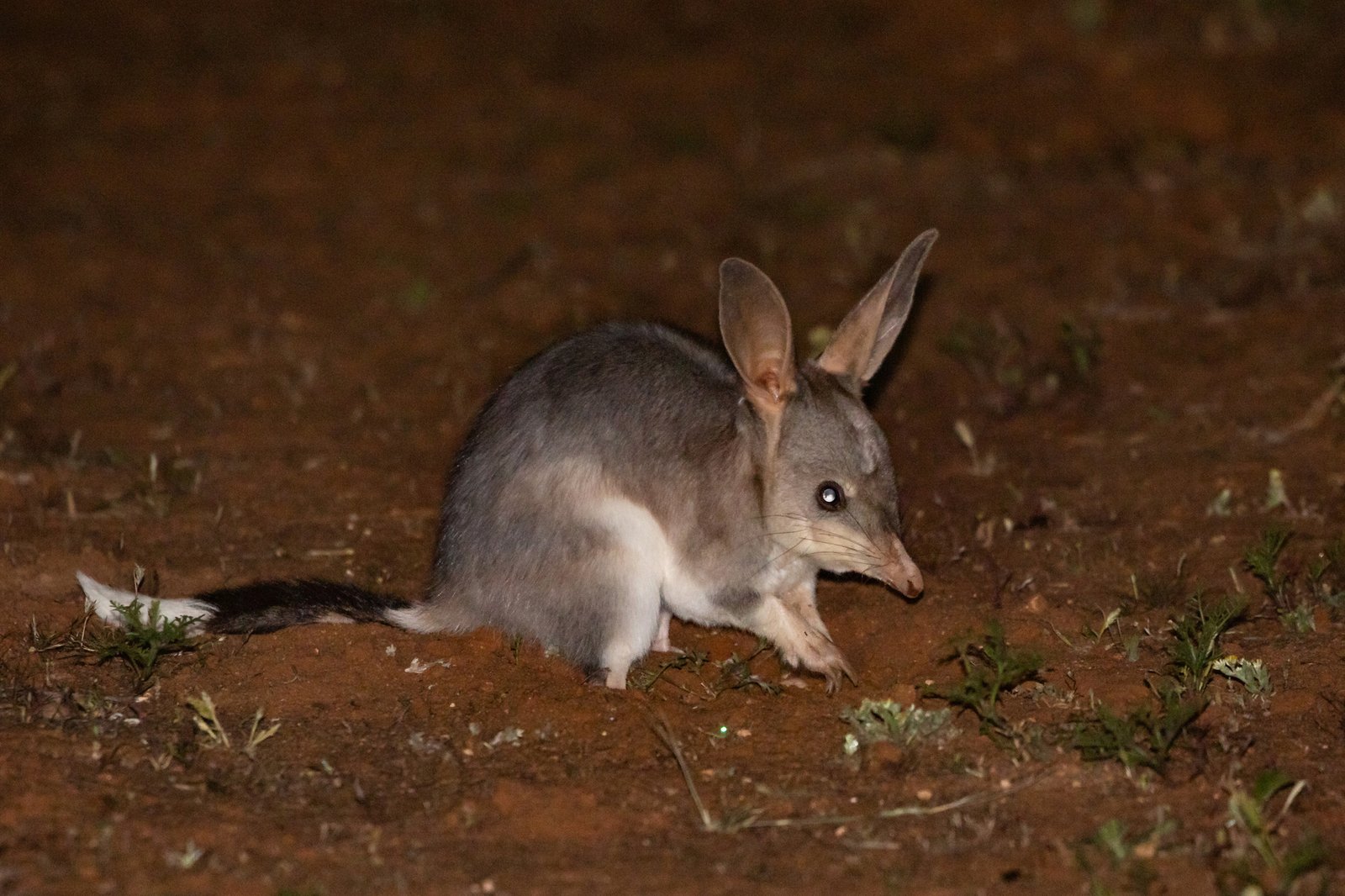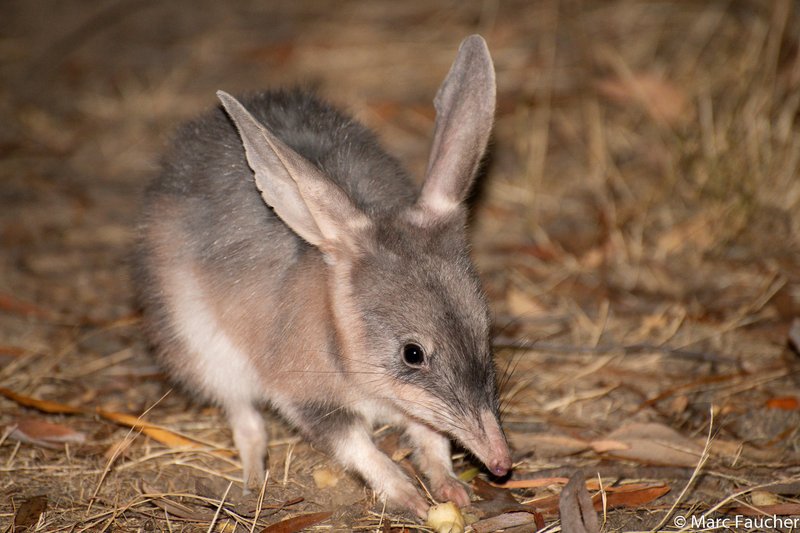Greater Bilby
The Greater Bilby, sometimes depicted as Australia's Easter Bunny, belongs to a group of ground-dwelling marsupials known as bandicoots. There were originally two species of Bilby- The Greater and the Lesser Bilby, Macrotis leucura, but the Lesser Bilby is thought to have become extinct in the 1950s.

© CC BY-NC 4.0
What do Greater Bilbys look like?
Identification
An endangered burrowing marsupial, the Bilby, Macrotis lagotis, is characterized by its long, silky blue-grey fur. Sometimes called the Rabbit-eared Bandicoot, it possesses long ears pinkish in colour. The body is compact in size featuring a pointed snout with a long tongue and a tail black and white in colour. Their strong forelimbs are adapted with long claws to assist in digging their burrows and uncovering buried food.
Males: body length:30-55cm, tail: 20-29cm, Females: body length; 29-39cm, tail: 20-28cm.
Where do Greater Bilbys live?
Habitat
Bilbies are found in a range of habitats from arid rocky soils with little ground cover to semi-arid shrublands and woodlands. They also known to inhabit spinifex and tussock grassland regions.
Distribution
Once common throughout the arid and semi-arid regions of the Australian mainland, European settlement has brought about changes in their habitat. The populations are now found within the Tanami Desert of the Northern Territory; in the Great Sandy and Gibson Deserts; parts of the Pilbara and Kimberley (near Broome) regions of western Australia; and the clayey and stony soils of the Mitchell grasslands of southwest Queensland.
Specimen in our collection
View microCT scans of a Greater Bilby (Macrotis lagotis) from the Australian Museum Mammalogy Collection (specimen AM M.39610). Learn more about microCT scanning and how it is used by the Australian Museum Research Institute.
What do Greater Bilbys eat and how have they adapted?
Feeding and diet
Sheltering in their burrows to avoid the heat of the day, Bilbies emerge after dark to forage for food. They can be seen scampering about sniffing for food which they dig out with their forefeet. Being omnivores, they will feed on a range of foods including insects (especially termites) and their larvae, seeds and fungi, bulbs and fruit.
Bilby feeding grounds are charactized by holes dug 10-25cm deep as they search for food. Because Bilbies have poor vision, they will also use their large ears and sharp sense of smell to track down food, their long sticky tongues helping them lick up seeds from the ground. Along with the seeds Bilbies will consume a certain amount of sand that then becomes part of their faecal waste. Besides sand, their scats can also contain insect exoskeletons which can be easily seen when the scat is broken open.
Water is not crucial to their diet as they are able to obtain enough moisture from their food.This is what makes their survival in arid regions so successful.
Other behaviours and adaptations
For daytime shelter, the bilby constructs a deep and long burrow system. Being a powerful digger, it is able to make spiral-shaped burrows up to 3 metres long and up to 2 metres deep.Predators attempting to dig an animal out often find it very difficult to locate any bilbies who will frantically extend the burrow at the closed end . Usually the depth allows safety for the bilby from predators as well as providing daytime protection from the heat. The opening is often against a termite mound or a tussock of grass and is always open. Some back filling is done within the burrow as a further protection device.
Burrows can be shared by males, females and their young which they will use, repair and re-use over many years.
Female bilbies have backward facing pouches like koalas and wombats so that dirt does not enter the pouch while they are digging.

© Australian Museum
What is the life cycle of Greater Bilbys and how do they breed?
Life history cycle
The life span of bilbies in the wild is about 7 years and they are able to breed from 6 months of age.
Breeding behaviours
Breeding season is usually between March and May but in captivity they will breed all year round. The pouch usually accommodates 2 young. As the gestation period is 14 days, female bilbies can give birth up to 4 times a year, producing up to 8 young. The young are attached to one of eight teats in the pouch, detaching from the teats around 11 to 12 weeks and become weaned by 13 to 15 weeks. The young will then live in the burrow for another couple of weeks, being fed by the mother's night time food foraging activities. By 5 months the female bilbies become sexually mature and be able to begin breeding.

© CC BY-NC 4.0
Are Greater Bilbys endangered?
Conservation status
From the arid interior of Australia to the temperate coastal areas, bilbies were common. But this was a hundred years ago. Today, changes in their habitat has seen their range reduced and their status listed as 'vulnerable'. They are now in competition with introduced animals and the demand for agricultural land. Sheep and cattle graze on the same plants as do rabbits, while foxes and feral cats have become predators. Even changing fire patterns have contributed to their demise in certain areas due to the impact on the type and availabilty of their food sources. This has led to only isolated populations surviving in pockets arid regions throughout Australia.
References
- Cronin Leonard:Cronin's Key Guide; Australian Wildlife Allen & Unwin 2007
- Gould League of Victoria; The Edge of Extinction: Australian Wildlife at Risk.
- Menkhorst P, Knight F: A Field Guide to the Mammals of Australia Oxford University Press 2004
- Strahan R: A Photographic Guide to the Mammals of Australia New Holland 1995.
- Strahan R: The Mammals of Australia Reed New Holland 1995.
Support the Australian Museum
Your donation supports the exceptional work of our inspiring scientists, explorers and educators as they help to protect Australia’s vital natural and cultural heritage for generations to come.
Donate now

